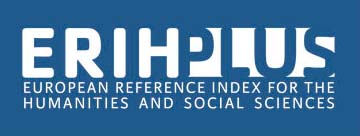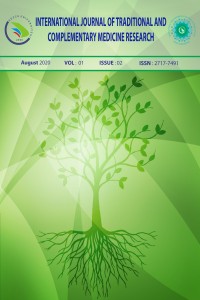Abstract
Objective: Recently, there is a growing interest in medicinal and aromatic plants also the treatment methods by using these plants in traditional and complementary medicine. On the other hand, possible toxicities of medicinal and aromatic plants has lately begun to be researched and it is extremely important to cognize these possibilities for human consumption. Therefore, a research has been conducted to understand the acute/subacute toxicity characteristics of a plant based herbal mixture, ISY-CP® used in remember regeneration therapy method (RTM) in rats. The product contains a mixture of nettle leaves (Urtica dioica), yarrow (Achillea millefolium), thyme (Thymus vulgaris) and horsetail (Equisetum arvense) plants. The aim of this research was to examine the effects of ISY-CP® herbal mixture in term of toxicity.
Material-Method: In the experimental design, 32 female rats were divided into 4 groups (control, acute, subacute and post-subacute). In order to observe acute and subacute toxicity, clinical observations were performed and the biochemical, hematological and histopathological parameters of the animals were evaluated at the end of the application.
Results: According to the results obtained from the study, there were not found significant differences in biochemical, hematological and histopathological evaluations between the control and the application groups. Only phorphorus data is statistically different between subacute toxicity group and control group.
Conclusion: In our study, the acute and subacute toxic effects of ISY-CP® herbal mixture’s doses used in this study were not observed.
Keywords
Traditional and complementary medicine acute toxicity subacute toxicity Urtica dioica Achillea millefolium Thymus vulgaris Equisetum arvense
References
- Jose Abad M, Miguel Bedoya L, Bermejo P. An Update on Drug Interactions with the Herbal Medicine Ginkgo biloba. Curr. Drug Metab. 2010;11, 171–181.
- Yasar M. The remember regeneration therapy method: An overview of new therapy protocol to approach diseases. J. Complement. Med. Res. 2019;10, 68.
- Yonar T and Kurt A. Treatability studies of hospital wastewaters with AOPs by Taguchi’s experimental design. Global NEST Printed in Greece. 2017; 19.
- Kurt A, Mert BK, Özengin N, Sivrioğlu Ö, Yonar T. Treatment of Antibiotics in Wastewater Using Advanced Oxidation Processes (AOPs). in Physico-Chemical Wastewater Treatment and Resource Recovery (InTech) 2017. doi:10.5772/67538
- Kurt A, Yonar T. Endokrin Bozucu Antibiyotik Bileşiklerinin UV/H2O2 Prosesi ile Taguchi Deneysel Dizaynına Göre Arıtılabilirliği. Afyon Kocatepe Üniversitesi Fen Ve Mühendislik Bilim. Derg. 2017; 17, 854–860
- Jatau AI, Aung MMT, Kamauzaman THT, Chedi BA, Sha’aban A, Ab Rahman AF. Use and toxicity of complementary and alternative medicines among patients visiting emergency department: Systematic review. J. Intercult. Ethnopharmacol. 2016; 5, 191.
- Zhang J, Wider B, Shang H, Li X. Ernst E. Quality of herbal medicines: Challenges and solutions. Complementary Therapies in Medicine 2012; 20, 100–106.
- Committee for Proprietary Medicinal Products (Cpmp). The European Agency for the Evaluation of Medicinal Products Evaluation of Medicines for Human Use Committee for Proprietary Medicinal Products (Cpmp) Note for Guidance on Repeated Dose Toxicity Discussion in The Safety Working Party. (2000).
- T. F. for M. Approaches towards Evaluation of Medicinal Plants prior to Clinical Trials The Foundation for Medical Research. 2006.
- 1Abba R S, Dare OO, Ibrahim JM. Hemorrhagic Centrolobar Necrosis and Cytoplasmic Vacuolation of the Hepatocytes in Syzygium Guineense Chronic Treated Mice. Int J Anat Appl Physiol 2018;4, 99–102.
- Anonymous. ISO 10993-11:2017(en), Biological evaluation of medical devices — Part 11: Tests for systemic toxicity. International Organization for Standardization 29 2017. Available at: https://www.iso.org/obp/ui/#iso:std:iso:10993:-11:ed-3:v1:en. (Accessed: 30th March 2020)
- Remirez DC. Update in Pre-Clinical Regulatory Requirements for Phytomedicines in Latin America. J. Complement. Integr. Med. 2006;3.
- Chhabra R S, Bucher J R, Wolfe M. Portier C. Toxicity characterization of environmental chemicals by the US National Toxicology Program: An overview. Int. J. Hyg. Environ. Health 2003;206, 437–445.
- Taylor D M, Walsham N, Taylor S E, Wong L. Use and toxicity of complementary and alternative medicines among emergency department patients. Emerg. Med. Australas. 2004;16, 400–406.
- Dar SA, Ganai FA, Yousuf, A. R., Balkhi, M. U. H., Bhat, T. M., and Sharma. Pharmacological and toxicological evaluation of Urtica dioica. Pharm. Biol. 2013;51, 170–180.
- Oktay M. Kabalcı Şifalı Bitkiler Ansiklopedisi. Kabalcı Yayınevi. 2016;4.
- Joshi B. C., Mukhija, M. and Kalia, A. N. Pharmacognostical review of Urtica dioica L. Int. J. Green Pharm. 2019;8, 23–30.
- Yaeesh S, Jamal Q, Khan A, Gilani AH. Studies on hepatoprotective, antispasmodic and calcium antagonist activities of the aqueous-methanol extract ofAchillea millefolium. Phyther. Res. 2006;20, 546–551.
- Hasheminia SM, Sendi JJ, Jahromi KT, Moharramipour S. The effects of Artemisia annua L. and Achillea millefolium L. crude leaf extracts on the toxicity, development, feeding efficiency and chemical activities of small cabbage Pieris rapae L. (Lepidoptera: Pieridae). Pestic. Biochem. Physiol. 2011;99, 244–249.
- Kagramanov KM. Effect of the essential oils of some thyme growing in Azerbaidzhan on cardiovascular activity and respiration. Azerbaidzhanskii Meditsinskii Zhurnal 1977;54, 49–51.
- Skramlik EV. On the toxicity and tolerance of ethereal oils. Pharmazie 1959;435–45.
- Fakılı O, Özgüven M. Türkiye’de Adı Kekik (Thymus vulgaris L.) Konusunda Yapılan Çalışmaların Envanteri. Ç.Ü Fen ve Mühendislik Bilim. Derg. 2012;27, 54–66.
- Hodson MJ, White P J, Mead A. Broadley MR. Phylogenetic Variation in the Silicon Composition of Plants. Ann. Bot. 2005;96, 1027–1046.
- Myagmar BE. Aniya Y. Free radical scavenging action of medicinal herbs from Mongolia. Phytomedicine 2000;7, 221–229.
- Dos Santos Junior JG, do Monte FHM, Blanco MM, Lanziotti VMDNB, Maia FD, de Almeida Leal LK. Cognitive enhancement in aged rats after chronic administration of Equisetum arvense L. with demonstrated antioxidant properties in vitro. Pharmacol. Biochem. Behav. 2005;81, 593–600.
- Miwa Y, Sakuma R, Iwasaki S, Shimizu M, Watanabe H. A safety toxicology study of equisetum arvense L. Pharmacometrics 2009;76, 61–69.
Abstract
References
- Jose Abad M, Miguel Bedoya L, Bermejo P. An Update on Drug Interactions with the Herbal Medicine Ginkgo biloba. Curr. Drug Metab. 2010;11, 171–181.
- Yasar M. The remember regeneration therapy method: An overview of new therapy protocol to approach diseases. J. Complement. Med. Res. 2019;10, 68.
- Yonar T and Kurt A. Treatability studies of hospital wastewaters with AOPs by Taguchi’s experimental design. Global NEST Printed in Greece. 2017; 19.
- Kurt A, Mert BK, Özengin N, Sivrioğlu Ö, Yonar T. Treatment of Antibiotics in Wastewater Using Advanced Oxidation Processes (AOPs). in Physico-Chemical Wastewater Treatment and Resource Recovery (InTech) 2017. doi:10.5772/67538
- Kurt A, Yonar T. Endokrin Bozucu Antibiyotik Bileşiklerinin UV/H2O2 Prosesi ile Taguchi Deneysel Dizaynına Göre Arıtılabilirliği. Afyon Kocatepe Üniversitesi Fen Ve Mühendislik Bilim. Derg. 2017; 17, 854–860
- Jatau AI, Aung MMT, Kamauzaman THT, Chedi BA, Sha’aban A, Ab Rahman AF. Use and toxicity of complementary and alternative medicines among patients visiting emergency department: Systematic review. J. Intercult. Ethnopharmacol. 2016; 5, 191.
- Zhang J, Wider B, Shang H, Li X. Ernst E. Quality of herbal medicines: Challenges and solutions. Complementary Therapies in Medicine 2012; 20, 100–106.
- Committee for Proprietary Medicinal Products (Cpmp). The European Agency for the Evaluation of Medicinal Products Evaluation of Medicines for Human Use Committee for Proprietary Medicinal Products (Cpmp) Note for Guidance on Repeated Dose Toxicity Discussion in The Safety Working Party. (2000).
- T. F. for M. Approaches towards Evaluation of Medicinal Plants prior to Clinical Trials The Foundation for Medical Research. 2006.
- 1Abba R S, Dare OO, Ibrahim JM. Hemorrhagic Centrolobar Necrosis and Cytoplasmic Vacuolation of the Hepatocytes in Syzygium Guineense Chronic Treated Mice. Int J Anat Appl Physiol 2018;4, 99–102.
- Anonymous. ISO 10993-11:2017(en), Biological evaluation of medical devices — Part 11: Tests for systemic toxicity. International Organization for Standardization 29 2017. Available at: https://www.iso.org/obp/ui/#iso:std:iso:10993:-11:ed-3:v1:en. (Accessed: 30th March 2020)
- Remirez DC. Update in Pre-Clinical Regulatory Requirements for Phytomedicines in Latin America. J. Complement. Integr. Med. 2006;3.
- Chhabra R S, Bucher J R, Wolfe M. Portier C. Toxicity characterization of environmental chemicals by the US National Toxicology Program: An overview. Int. J. Hyg. Environ. Health 2003;206, 437–445.
- Taylor D M, Walsham N, Taylor S E, Wong L. Use and toxicity of complementary and alternative medicines among emergency department patients. Emerg. Med. Australas. 2004;16, 400–406.
- Dar SA, Ganai FA, Yousuf, A. R., Balkhi, M. U. H., Bhat, T. M., and Sharma. Pharmacological and toxicological evaluation of Urtica dioica. Pharm. Biol. 2013;51, 170–180.
- Oktay M. Kabalcı Şifalı Bitkiler Ansiklopedisi. Kabalcı Yayınevi. 2016;4.
- Joshi B. C., Mukhija, M. and Kalia, A. N. Pharmacognostical review of Urtica dioica L. Int. J. Green Pharm. 2019;8, 23–30.
- Yaeesh S, Jamal Q, Khan A, Gilani AH. Studies on hepatoprotective, antispasmodic and calcium antagonist activities of the aqueous-methanol extract ofAchillea millefolium. Phyther. Res. 2006;20, 546–551.
- Hasheminia SM, Sendi JJ, Jahromi KT, Moharramipour S. The effects of Artemisia annua L. and Achillea millefolium L. crude leaf extracts on the toxicity, development, feeding efficiency and chemical activities of small cabbage Pieris rapae L. (Lepidoptera: Pieridae). Pestic. Biochem. Physiol. 2011;99, 244–249.
- Kagramanov KM. Effect of the essential oils of some thyme growing in Azerbaidzhan on cardiovascular activity and respiration. Azerbaidzhanskii Meditsinskii Zhurnal 1977;54, 49–51.
- Skramlik EV. On the toxicity and tolerance of ethereal oils. Pharmazie 1959;435–45.
- Fakılı O, Özgüven M. Türkiye’de Adı Kekik (Thymus vulgaris L.) Konusunda Yapılan Çalışmaların Envanteri. Ç.Ü Fen ve Mühendislik Bilim. Derg. 2012;27, 54–66.
- Hodson MJ, White P J, Mead A. Broadley MR. Phylogenetic Variation in the Silicon Composition of Plants. Ann. Bot. 2005;96, 1027–1046.
- Myagmar BE. Aniya Y. Free radical scavenging action of medicinal herbs from Mongolia. Phytomedicine 2000;7, 221–229.
- Dos Santos Junior JG, do Monte FHM, Blanco MM, Lanziotti VMDNB, Maia FD, de Almeida Leal LK. Cognitive enhancement in aged rats after chronic administration of Equisetum arvense L. with demonstrated antioxidant properties in vitro. Pharmacol. Biochem. Behav. 2005;81, 593–600.
- Miwa Y, Sakuma R, Iwasaki S, Shimizu M, Watanabe H. A safety toxicology study of equisetum arvense L. Pharmacometrics 2009;76, 61–69.
Details
| Primary Language | English |
|---|---|
| Subjects | Traditional, Complementary and Integrative Medicine |
| Journal Section | Research Articles |
| Authors | |
| Publication Date | August 27, 2020 |
| Submission Date | May 27, 2020 |
| Published in Issue | Year 2020 Volume: 1 Issue: 2 |
IJTCMR
International Journal of Traditional and Complementary Medicine Research





